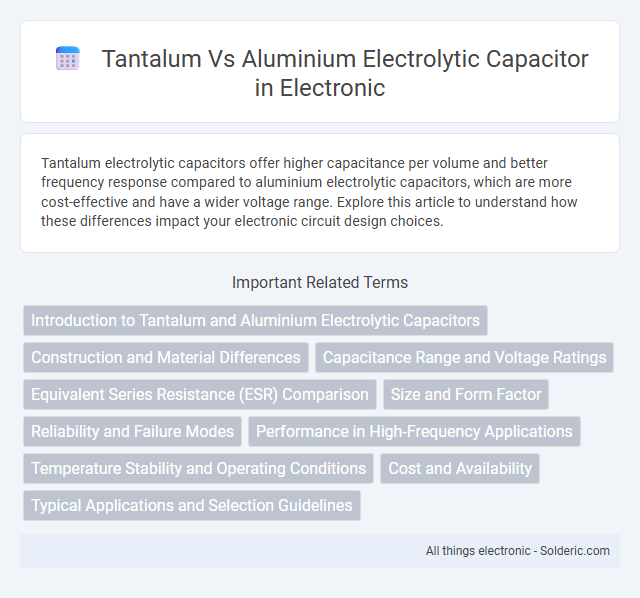Tantalum electrolytic capacitors offer higher capacitance per volume and better frequency response compared to aluminium electrolytic capacitors, which are more cost-effective and have a wider voltage range. Explore this article to understand how these differences impact your electronic circuit design choices.
Comparison Table
| Feature | Tantalum Electrolytic Capacitor | Aluminium Electrolytic Capacitor |
|---|---|---|
| Dielectric Material | Tantalum pentoxide (Ta2O5) | Aluminium oxide (Al2O3) |
| Capacitance Range | 0.1 uF to 470 uF | 1 uF to 10,000 uF |
| Voltage Rating | Up to 50V typically | Up to 450V and higher |
| ESR (Equivalent Series Resistance) | Low ESR | Higher ESR |
| Leakage Current | Lower leakage current | Higher leakage current |
| Size | Smaller, compact size | Larger, bulkier |
| Reliability | High reliability with stable capacitance | Moderate reliability with capacitance variance |
| Cost | Higher cost | Lower cost |
| Failure Mode | Short circuit failure possible | Open circuit failure typical |
| Applications | High performance circuits, space-limited designs | Power supplies, decoupling, general purpose |
Introduction to Tantalum and Aluminium Electrolytic Capacitors
Tantalum and aluminium electrolytic capacitors are essential components in electronic circuits, offering distinct advantages based on their materials and construction. Tantalum capacitors provide high capacitance per volume, excellent stability, and low equivalent series resistance (ESR), making them ideal for compact, high-performance applications. Aluminium electrolytic capacitors typically deliver larger capacitance values at a lower cost, with robust voltage ratings suited for power supply filtering and general-purpose uses in your electronic designs.
Construction and Material Differences
Tantalum electrolytic capacitors use a sintered tantalum pellet as the anode, covered with a manganese dioxide or conductive polymer cathode, creating a stable dielectric layer of tantalum pentoxide that offers high capacitance per volume and superior performance in low-voltage applications. Aluminium electrolytic capacitors feature an etched aluminium foil anode coated with an aluminium oxide dielectric layer, combined with a liquid electrolyte, which provides cost-effective high capacitance values but with larger size and lower stability compared to tantalum capacitors. The choice of materials and construction results in tantalum capacitors being more compact with better frequency response, while aluminium capacitors deliver higher capacitance and voltage ratings suitable for bulk energy storage.
Capacitance Range and Voltage Ratings
Tantalum electrolytic capacitors typically offer capacitance values ranging from 0.1 uF to 470 uF with voltage ratings between 2V and 50V, making them ideal for compact, high-stability applications. Aluminium electrolytic capacitors provide a broader capacitance range of 1 uF up to 1,000,000 uF and voltage ratings from 6.3V to 500V, suited for power supply filtering and bulk energy storage. Selecting Your capacitor depends on the required capacitance and voltage, with tantalum favored for lower voltage and stable capacitance and aluminium preferred for higher voltage and larger capacitance needs.
Equivalent Series Resistance (ESR) Comparison
Tantalum electrolytic capacitors typically exhibit a lower Equivalent Series Resistance (ESR) compared to aluminium electrolytic capacitors, resulting in better performance in high-frequency applications with reduced heat generation. Your choice of capacitor influences circuit stability and efficiency, especially where low ESR is critical for filtering and decoupling tasks. Aluminium capacitors may have higher ESR but often offer superior surge current tolerance, making them suitable for power supply smoothing where transient loads are significant.
Size and Form Factor
Tantalum electrolytic capacitors typically offer a smaller size and more compact form factor compared to aluminum electrolytic capacitors, making them ideal for space-constrained electronic designs. You can benefit from tantalum's stable capacitance and longer lifespan in compact circuits, while aluminum capacitors tend to be bulkier but provide higher capacitance values. Choosing between these depends on your project's size requirements and performance needs.
Reliability and Failure Modes
Tantalum electrolytic capacitors offer superior reliability with lower Equivalent Series Resistance (ESR) and longer lifespan compared to aluminum electrolytic capacitors, making them ideal for applications requiring stable performance under high temperatures. Aluminum capacitors are more prone to electrolyte leakage and drying out over time, leading to increased ESR and eventual failure, typically through open circuit or short circuit modes. When selecting capacitors for critical circuits, your choice between tantalum and aluminum should consider the specific failure modes and reliability demands of the application.
Performance in High-Frequency Applications
Tantalum electrolytic capacitors provide stable capacitance and low equivalent series resistance (ESR), making them suitable for high-frequency applications requiring reliable filtering and timing functions. Aluminium electrolytic capacitors generally exhibit higher ESR and inductance, which can limit their effectiveness in high-frequency circuits where minimal signal loss is critical. Designing circuits with tantalum capacitors enhances performance by maintaining consistent capacitance and reducing noise at elevated frequencies.
Temperature Stability and Operating Conditions
Tantalum electrolytic capacitors offer superior temperature stability, maintaining consistent capacitance and low equivalent series resistance (ESR) across a wide temperature range of -55degC to +125degC. Aluminium electrolytic capacitors typically operate within -40degC to +85degC and may experience greater capacitance loss and increased ESR at elevated temperatures. For your application, selecting tantalum capacitors can enhance reliability under demanding thermal conditions and harsh operating environments.
Cost and Availability
Tantalum electrolytic capacitors typically cost more than aluminum electrolytic capacitors due to the scarcity and higher processing costs of tantalum metal. Aluminum electrolytic capacitors are widely available and produced in larger volumes, making them more cost-effective for general applications. Your choice depends on budget constraints and the need for stable performance versus affordability and easy accessibility.
Typical Applications and Selection Guidelines
Tantalum capacitors excel in applications requiring stable capacitance, low Equivalent Series Resistance (ESR), and long-term reliability, making them ideal for military, aerospace, and medical devices. Aluminium electrolytic capacitors are preferred in power supply filtering and high ripple current applications due to their higher capacitance values and cost-effectiveness. Selection guidelines emphasize choosing tantalum capacitors for circuits sensitive to voltage spikes and temperature variations, while aluminium electrolytics suit bulk energy storage and audio frequency filtering.
Tantalum vs Aluminium Electrolytic Capacitor Infographic

 solderic.com
solderic.com